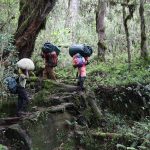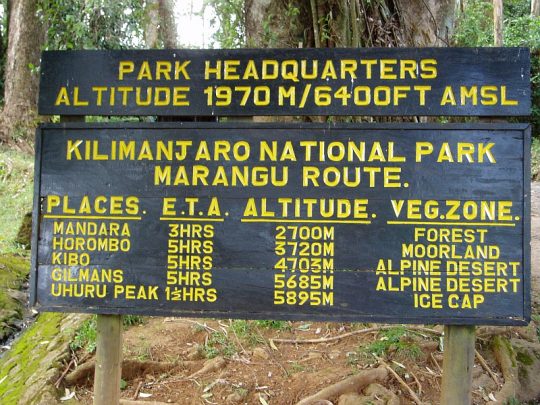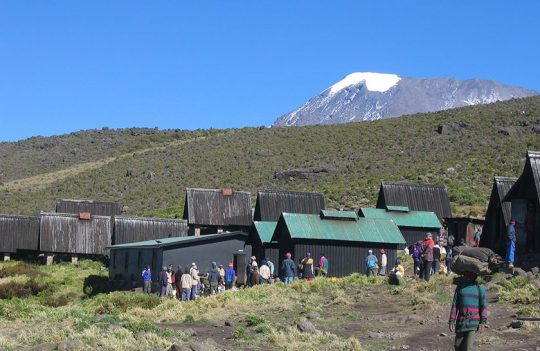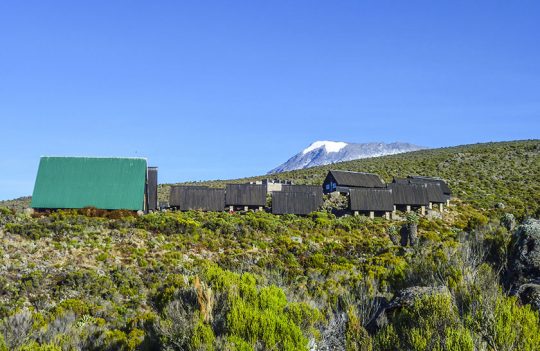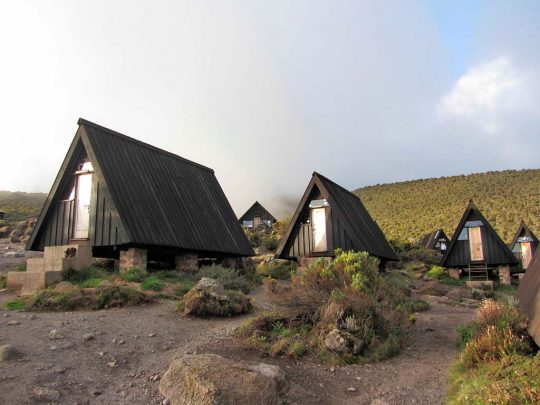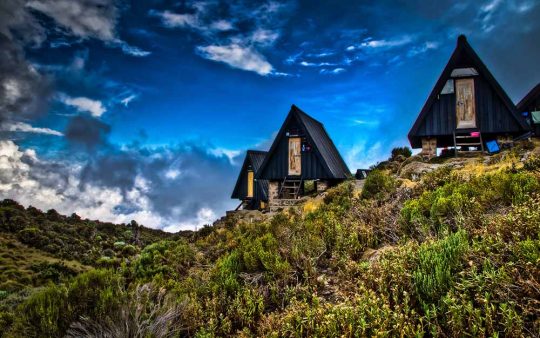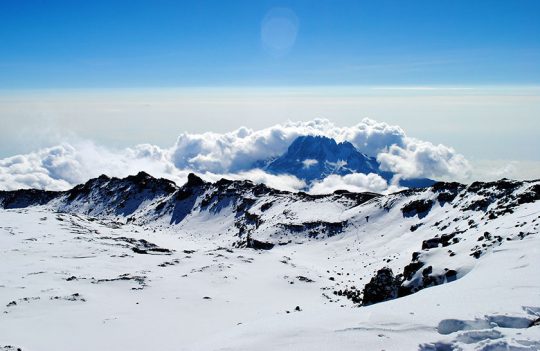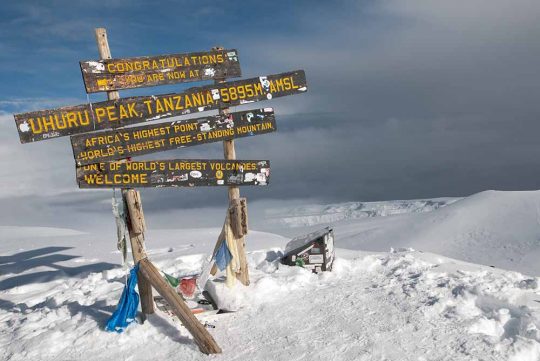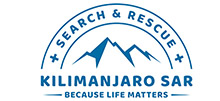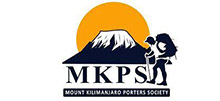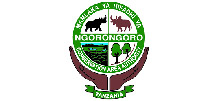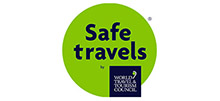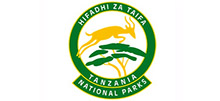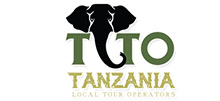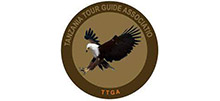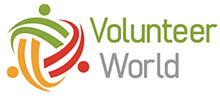Known as the ‘Coca Cola Route’ because of its popularity and its relative ease, the Marangu route is the least difficult and the shortest way to Uhuru Peak. For those that can’t bear sleeping in a tent or during the wettest months, the Marangu Route remains a good choice.
The original route up to Mt. Kilimanjaro summit remains a popular choice for many climbers. The advantage of this route is the accommodation facilities. It has permanent shared huts with bunk beds at the campsites. This route is fairly easy but the final part to the summit is still difficult. Summit night from Kibo Hut is steep and passes Gilman’s Point to Uhuru Peak. Since it is a shorter route with a steeper incline and less time for acclimatization it tends to have a lower summit success rate. Though this route is the easiest, it has the highest failure rate due to bad preparation for many hikers. A 6-day option is strongly recommended over the 5-day one for better acclimatization. This is the only route where the ascent and descent route is shared, thus creating more traffic.
Kilimanjaro: afromontane forest, Mawenzi, glacial valleys and alpine desert, ascent of Kibo and possible views of Kibo caldera and ash pit. Glaciers and the roof of Africa!
DAY 1 - TREKKING FROM MARANGU GATE TO MANDARA HUT
Today you will commence the trekking of Mt. Kilimanjaro, Africa’s highest mountain. After early morning breakfast from your hotel/lodge, our mountain support team will arrive to meet you and hold a quick briefing. Then you will be transferred by vehicle to Kilimanjaro National Park’s eastern entrance: Marangu Gate (1,860 m). Upon arrival at the gate, we will patiently wait for the permits formalities to be issued and registrations. Here you will witness the hustle and bustle of operations as many crews prepare for the journey ahead.
Once the permits are settled, we will begin our ascent through the verdant rainforest that clothes the lower reaches of Kilimanjaro up to Mandara Hut (2,700 m). A picnic lunch is taken on route. Enjoy the beautiful rainforest scenery and windy trails while your guide tells you about the local flora and fauna and natural wildlife. Day one is a gradual trek through the Kilimanjaro rainforest. Hiking for 4 – 6 hours through this ancient jungle, you’ll get to go on a miniature safari as you spot wildlife such as black and white colobus monkeys along the way. At these lower elevations where tropical showers are highly probable, the trail can be muddy and quite slippery. We highly recommend you take your raincoat, gaiters and trekking poles among others. When you reach the camp, your mountain support team will take care of the necessities and meals preparations.
ELEVATION: 1,860 M to 2,700 M
DISTANCE: 11 KM
TREKKING TIME: 4 – 6 Hours
HABITAT: Montane ForestDAY 2 - TREKKING FROM MANDARA HUT TO HOROMBO HUT
Day two on the Marangu Route begins with an early start, as we’ve got a long day of hiking ahead. After breakfast, the group will depart Mandara Hut to start a moderate trek towards the second-high altitude camp: Horombo Hut (3,720 m). We emerge from the rain forest and continue on an ascending path, through heathland, looking for giant lobelias and groundsels. We continue up into open moorlands where small shrubs are the main vegetation. The altitude gain today is significant and so a gentle pace is ideal to slowly gain altitude. By mid-afternoon you reach camp and can relax. If the weather is clear you should definitely take the opportunity to scramble up the Maundi Crater (2.5 Km) for an acclimatization hike to get your first full view of Kibo, then descend back to Horombo Hut.
ELEVATION: 2,700 M to 3,720 M
DISTANCE: 10 KM
TREKKING TIME: 5-7 HRS
HABITAT: Montane Forest/Heather and MoorlandDAY 3 - TREKKING FROM HOROMBO HUT TO KIBO HUT
On this day, you start off early to the Kibo Hut (4,720 M) before the summit attempt. The actual trekking is not very difficult, just remember to stick with an appropriate pace to keep up your strength in this hypoxic (low oxygen) environment. We will hike through the dwindling heathland that blends into a moonscape as we enter the sweeping saddle connecting Mawenzi and Kibo. When you reach the camp you will be served lunch, after which we recommend you sleep as much as you can, avoid any strenuous activity, and drink lots of water. A relatively early dinner is taken as the night will be short. Make sure that you have all your gear ready for a prompt departure after mid-night for the summit hike.
ELEVATION: 3,720 M to 4,720 M
DISTANCE: 10 KM
TREKKING TIME: 6 -7 HRS
HABITAT: Heather/Alpine DesertDAY 4 - TREKKING TO UHURU PEAK AND DESCEND TO HOROMBO HUT
Today you’re starting your day early – just after midnight. Your mountain support team will wake you up with a cup of hot tea and a light snack for energy as you get dressed and prepare your daypack for the adventure ahead. This is the most mentally and physically challenging portion of the trek. We start out from Kibo Hut towards the Uhuru Peak. At night time the scree sections are normally much firmer and the night time start enables the best chance of a clear summit attempt. It takes around 6 hours to reach Gilman’s Point and then a further 1.5 to 2 hours to reach your ultimate goal: Uhuru Peak (Alt 19,341ft, 5985m) the top of the highest free standing mountain in the world and the roof of Africa!
At the summit, you’ll be able to experience a spectacular sunrise and take in the panoramic view. After photos, celebrations and maybe a few tears of joy we take a few moments to enjoy this incredible accomplishment, we’ll will return to Kibo Camp for a refuel and rest. Then we continue descending to Horombo Hut (3,720 m) for dinner and enjoy your last evening on the mountain. This is surely the longest and most grueling day of the entire trek.
ELEVATION: 4,720 M – 5,985 M – 3,720 M
DISTANCE: 16 KM
TREKKING TIME: 9 -12 HRS
HABITAT: Alpine Desert/Arctic/HeatherDAY 5 - DESCEND FROM HOROMBO HUT TO MARANGU GATE
After a warm breakfast in the morning, we continue the descent down stopping at the Mandara Huts for lunch. This final descent takes you back through the heath zone and forest to the Kilimanjaro National Park’s exit: Marangu Gate (1,860 m). As the weather is drastically warmer, the terrain is wet, muddy and steep, we highly recommend gaiters and trekking poles.
Hopefully you had a great time with your mountain support team, but it’s time to say goodbye. Remember to tip your guides, cooks, and porters, since you will be leaving them here.
From the gate, our transfer vehicle will drive you back to your hotel/lodge. Enjoy a long overdue hot shower, dinner, and celebrations! Later that evening you will be visited by our representative to congratulate you, to find out how the trip went and to answer any final questions you may have about your onward journey.
ELEVATION: 3,720 M to 1,860 M
DISTANCE: 21 KM
TREKKING TIME: 6 -7 HRS
HABITAT: Heather/Montane Forest
- Transfer to / from the mountain gate
- Professional mountain support crew (including; professional qualified mountain guide, assistant guides, adequate porters, cook etc)
- All meals on the hike. You will find delicious energy-rich meals on our mountain menus. Our cook will prepare assorted soups, garnishes, several types of fish and meat, fresh fruit and vegetables. Vegetarian/gluten-free/halal options are available upon request
- Drinks on the hike (coffee, tea, hot chocolate and water)
- Kilimanjaro National Park Permits Fees
- Kilimanjaro National Park Rescue Fees
- Camping Equipment (tents, table, chairs, crockery and cutlery)
- First aid kit
- Flying Doctors Rescue Insurance during your trip
- International certificates for a successful ascent
- Fair wages for the mountain support crew as approved by the Kilimanjaro National Park Authority (KINAPA) & Kilimanjaro Association of Tour Operators (KIATO)
- Walking poles
- Oxygen cylinders and oximeters
- Free storage of excess luggage not required on the mountain trekking
- Government Taxes (VAT, TDL and Service Levy. Mucho Tours & Safaris is an honest and responsible Tour Operator working in full compliance with the tax law of the United Republic of Tanzania)
- International & Domestic Flights tickets
- Visa Fees
- Travel & Medical Insurance
- Accommodations before & after the trekking
- Tipping & gratuities for your mountain support crew (Highly Recommended)
- Expenses of Personal nature; extra beverages, energy food, souvenirs etc.
- Personal mountain gears (hiring service available)
- Any excess luggage more than 15 Kg per person while trekking
- Cost of any requested itinerary modification while the trekking is in progress
- All statutory increases beyond our control
- Laundry services
How many days early should I arrive?
We recommend arriving one day early (what we refer to as “arrival day”). This will give you time to relax and get a proper briefing before the climb starts. More importantly, if there’s any delay to your flight or your luggage goes AWOL, there’s enough wiggle room so that this delay doesn’t derail your climb.
What is the best time of year to climb Mount Kilimanjaro?
You can climb any month of the year. At lower elevations, April, May, and November are quite wet while March and June are transitional months. August and September are the coldest and driest months. January, February, July, August, and September are all popular climbing months. If you have a particular event or day you would like to be standing on the summit, we will arrange that.
Which is the best route?
How far do I hike each day?
Depending upon the selected route, you may trek an average of 4-8 hours per day with the summit day being the longest. Most days, other than the summit day, will begin with breakfast around 6:30 AM and departure at 7 AM. You will walk four to five hours with a break for lunch followed by another hour or two of hiking in the afternoon. These days are not long or difficult and you will be advised to walk slowly – Pole pole.
Why do we make the final ascent in the pre-dawn darkness?
The final ascent requires patience and persistence to reach the summit (Uhuru Peak: 19341ft, 5895m). Normally, we start the ascent around midnight, depending on the perceived fitness of the group, the weather and the route. The pre-dawn hours are ideal to start the ascent to the summit as it is cold but also calm and clear. It is rare find cloudy weather at the summit at dawn any time of year and at dawn, you have the best view.
On the other hand, if you leave in early morning, it could be very windy and the ascent becomes more difficult. The ascent day is a long hiking day, so it is better start early and walk slowly. It can take up to 15 hours to reach the summit and descend to the camp for that night.
How much weight will I have to wear and where can I leave unnecessary luggage?
You will simply carry a day pack of about two to four kilograms, although some people carry more or less. Your gear (not to exceed twelve kilograms) will be placed inside a waterproof duffle at the trail head and a porter will carry this for you. If you have things that you do not need on the climb, you may leave them at our office.
How do I get to Mt Kilimanjaro?
Kilimanjaro International Airport (JRO) is the most convenient arrival airport, sitting only 42 km away from the mountain town of Moshi and 50 km from Arusha.
Who will accompany me during the climb?
The usual ratio is three or four crew members for each climber, although small groups may have four or five of them. The mountain crew support usually consists of an English speaking guide or guides, a professional cooker, and gear-carrying porters. We encourage you to interact with your staff. They are all trustworthy, local people who have grown up in the shadow of the mountain. Many of them have climbed the peak a hundred or more times.
What kind of tents will I sleep in? What are the huts on the Marangu Route like?
Your tents are mountain-style, double-walled, mosquito-netted, and durably-floored with waterproof material. While technically rated as three-person tents, they accommodate two people very comfortably. Tents are erected and packed up by our mountain support crew. There is enough space for tall people to stretch out and room for your gear within the tent. On the Marangu Route, the huts are just large enough for four bunks built against the walls of A-frame cubicles. Tall hikers will feel cramped. Gear is stored on the floor. Wash and toilet facilities are shared and are outside of the bungalows.
What is the food like?
We understand that sufficient caloric intake and purified water are essential to keep the body functioning properly high up on the mountain. Our menu is specific to the activities of that day, and day of trekking ahead. By incorporating the right balance of carbohydrates and proteins, we keep our clients in top health.
We have vegetarian & vegan menus available and accommodate gluten free and do our best with other special dietary situations.
The following are a sample of our menu items:
Breakfast
- Tea, Coffee, Hot Chocolate
- Toast, Biscuits with Margarine, Jam, Peanut Butter
- Eggs, meat, sausage
- Porridge
- Fresh fruits: Mango, Banana, Avocado, Watermelon, Oranges
Lunch
- Tea, Coffee, Hot Chocolate
- Chicken or Vegetable Soup
- Bread, Biscuits or Pancakes with Jam, Peanut Butter
- Sandwich with Meat or Cheese, Boiled Egg
- Snack: Peanuts, Popcorn, Cake, Cookies
- Fresh fruits and Fruit Salad: Tomato, Cucumber, Onion, Carrots
Dinner
- Tea, Coffee, Hot Chocolate
- Chicken or Vegetable Soup
- Bread, Biscuits or Pancakes with Jam, Peanut Butter
- Roasted Chicken, Beef or Fish
- Potatoes, Rice, Pasta
- Fresh Vegetables: Carrots, Peas, Tomato, Beans
What happens if I need to descend before the summit?
No one is forced to go on. There is always enough staff to split the group accordingly to needs and regroup later at the camp. Most people have no trouble reaching the highest campsite. If some party members decide not to climb the final distance to the peak or cannot proceed at any point in time, they can wait for the other group climbers to come back or can go down with a guide following the same way or take a lateral path to the descent route.
What kind of help is available in case of an emergency?
We always have a first aid kit with us and guides are well trained on first aid. Serious injuries are very rare and Kilimanjaro National Park has a rescue team in case of emergency.
What kind of equipment and clothing should I bring?
- Travel bag, backpack or kitbag, weighing no more than 12kg. Please do not bring a suitcase or trolley bag, as this type of luggage cannot be carried by the porters.
- Day backpack with rain protection.
- High quality sleeping bag for harsh conditions (at night temperatures can drop to -20°C).
- Different layers of clothing including thermal base layers, fleece clothing, trekking pants, warm jacket and water-resistant top layers as well as a warm headgear.
- Water-resistant and comfortable hiking boots and a variety of trekking socks.
- Please note that the above list is not complete and these are just a few things that you will have to bring with you. Once we have confirmed your booking, you will receive a more detailed list.
Do I need to get any vaccinations before I leave?
There are no specific vaccine requirements for entry into Tanzania. However, be aware that the Government of Tanzania requires proof of yellow fever vaccination upon arrival if you are travelling from a country with risk of yellow fever. Also COVID vaccination certificate or PCR Test results less than 72 hours.
While it’s not mandatory by any means, we suggest you talk to your doctor about getting the following vaccinations (which are standard in developed countries): Hepatitis A & B, typhoid, yellow fever, tetanus, polio, MMR (measles, mumps and rubella) and meningococcal meningitis (Africa and Asia).
Will I need a VISA for Tanzania?
Yes, you can obtain it online. Please also note that you need a passport that’s valid for at least six months after your departure date.
Can I find cheaper prices for the same route?
The major sources of cost variations are the money spent on food, off-mountain accommodation, porter and guide wages, tents, and the cost of getting to the mountain.
Mucho Tours & Safaris is determined to provide the best food, best guides and porters, best tents and equipment, top quality before-and-after-climb accommodation, a full professional pre-climb orientation, insurance for all staff and inclusion of all park permits, meals, transfers and local hosting costs.Cheap operators may sacrifice:
- Safety equipment
- Contract out your climb to unknown companies
- Non-certified guides with no medical training
- Neglect proper cooking preparations
- Exclude private sanitary facilities
- Poor group equipment
- Select quick and crowded routes
- the list can go on and on….
Our approach is not to provide the cheapest trip, but rather to do everything we can to increase the likelihood you will reach the summit and enjoy the overall experience with a staff of people who are well qualified and compensated for the extraordinary assistance they provide to you.
How much should I tip the staff?
On Kilimanjaro and Safari tipping is an expected practice for the crew who assist you. As a general rule USD$250 to USD$300 per person will adequately cover crew tips on the mountain.
Should I use Altitude medication?
The majority of climbers have not been at high altitude before and do not know how their body will react. Diamox (generic name Acetazolamide) is a carbonic anhydrase inhibitor, which means it forces the kidneys to expel bicarbonate, thus re-acidifying the blood. The drug forces the kidneys to emit bicarbonate. By increasing the amount of bicarbonate removed to the urine, the blood becomes more acidic. Acidifying the blood stimulates ventilation, which increases the amount of oxygen in the blood and has shown to decrease the detrimental effects of altitude on the body.
This is a personal choice and has been known to assist clients with minimizing the effects of altitude. This should ultimately be a decision between you and your physician.
Is Mt Kilimanjaro a technical climb?
No, in the sense that no prior climbing experience is needed. However, this should not lead to the notion that this is a simple hike. A Kilimanjaro climb is a very special type of adventure, beyond a traditional vacation. Unlike popular beach vacations or simple hiking tours, climbing Mount Kilimanjaro requires certain preparations. After all, this adventure takes hikers to the highest point of Africa at 5,895 m/19,340 f. This is often the highest altitude many climbers to ever achieve, making this trip a true adventure of a lifetime. The Climb Kili personal Fitness Program will prepare your body and mind for the daily trekking and rigors of the mountain.
Should I climb Kilimanjaro?
Yes! The challenge is real, but absolutely worth it. Over the course of several days, you and your team journey through a tropical rainforest and transition to an Alpine Desert, ending in an Arctic climate, while still in Africa. Camping along scenic routes overlooking Tanzania, while you trek the famous volcano Kilimanjaro is the experience of a lifetime. Finally, you can stand on Uhuru Peak and watch the sun rise up over the curve of the earth from the highest point in all of Africa.
Advice for women climbing Mt Kilimanjaro
Here are three (very valid!) questions we’re often asked by women preparing to climb Mt Kilimanjaro:
- Where do I go to the toilet during the climb?
- How can I keep clean during the climb?
- How do I manage my period on the climb?
Where do I go to the toilet during the climb?
Needing to wee and not being able to go … we’ve all been there, and it’s stressful! When climbing Kilimanjaro, you’ll need to wee fairly often. Altitude makes us urinate more frequently plus you’ll be drinking more water than usual. So here’s some basic info and advice when it comes to:
- peeing while hiking
- pooping while hiking
- the toilet tent at camp
Peeing while hiking
You’ll be drinking a lot of water during your Kilimanjaro climb. In fact, you should be drinking a minimum of three litres a day! That means you’ll be needing to go to the toilet a lot. Additionally, the higher you climb, the more often you need to go, as altitude makes you urinate more frequently.
Some women climbing Kilimanjaro like to use a Shewee or similar urinating device to make it easier to take a leak whilst hiking. These devices let you wee in a similar way to a man: you just need to turn your back on the crowd, unzip your trousers and push your knickers aside, then wee into the contraption. The funnel ensures your wee comes out in a stream away from your feet. We suggest you opt for a device that comes with a storage container.
Urinating devices
Female urinating devices are, of course, all about personal preference. But know that you won’t be the only one using it on the mountain. The higher up the mountain you climb, the less vegetation there is to hide behind for dropping your trousers and copping a squat. The ‘bush’ toilet will turn into a ‘rock’ toilet. You might also find during tiring stretches of the hike that you’re grateful for the heightened ease and efficiency offered by the Shewee.
Pooping while hiking
Hiking at altitude often makes bowel movements more frequent. So it’s quite likely that you’ll need to pooh while on the trail. It’s best to prepare yourself mentally and practically for this (deciding you won’t need to go before reaching camp, or that you’ll talk your bowel into submission, isn’t really a plan, and just provides unnecessary stress).
The toilet tent in camp
Unless you’re hiking the Marangu route, which provides permanent hut accommodation, you’ll usually be using a portable toilet inside a tent when in camp. Most tour operator provides its trekkers with a private toilet tent. Be sure to check your trip inclusions. If a private toilet is not listed here, you will be using the public toilets at camp.
How can I keep clean during the climb?
Keeping clean on a Kilimanjaro climb is an interesting exercise. At no point on the mountain is there showers available, unless you’re hiking the Marangu route, which does offer cold showers. For the rest of us hiking one of the other seven Kilimanjaro routes, there’ll be no showering during the trek. And that means we’ll all be getting a bit smellier than normal.
Hair
You’re going to be on the mountain for around seven days without a shower. So it’s a good idea to plan ahead of time what you want to do about your hair. And since everyone’s hair is different, we suggest making a game plan based on what you know about your own hair.
Obviously a good idea is to wash your hair just before you head to the mountain, that way you’re golden for the first couple of days. After that, consider tying longer hair in a plait to limit the dust that can settle on it. Giving it a brush at night should also help to remove a bit of dust and any freeloaders like the odd small leaf.
From then on, the plan might simply be a bandanna, beanie or cap that keeps it covered. And that’s a solid, Kili-stlye plan. We suggest you might like to use the head cover as well as utilise a little baby powder or dry shampoo at the roots, to keep the oiliness under control. Be sure also that your hair tie (if you have long hair) is sturdy, or that you have a backup band should yours break or get lost.
Nails
We recommend cutting your nails short just before starting the trek to avoid (too much) dirt getting under them. A small scrubbing brush and a toothpick for cleaning under your nails might also be good ideas. If the sight of dirty nails horrifies you, then we recommend wearing a dark nail polish to hide the dirt.
How do I manage my period on the climb?
According to the International Climbing and Mountaineering Federation, a woman’s menstrual cycle can be affected by changes in altitude, particularly a great increase in altitude. This means climbing up Mt Kilimanjaro could well result in ‘surprises’, from causing your period to stop before usual to causing it to be early, irregular or longer than the norm. Basically, your period should be thought of as a wildcard on a high-altitude trek. And this means that every lady with a period should prepare to deal with it on the climb, even if you’re trekking at a time that you know you shouldn’t get it.
How do I shower and use the loo?
This is an outdoor adventure trip in the African wild. There are no showers on the mountain. Warm water will be supplied in a bowl and you will be able to wash your face and hands. For the rest you can bring wet wipes. At each campsite, we set up a private toilet tent which contains a plastic toilet. If you need to use the bathroom on the trail, you’ll find a spot behind a tree or rock. But you’ll need to have a little baggie for putting used toilet paper in that you then carry to camp and dispose of in a bin.


